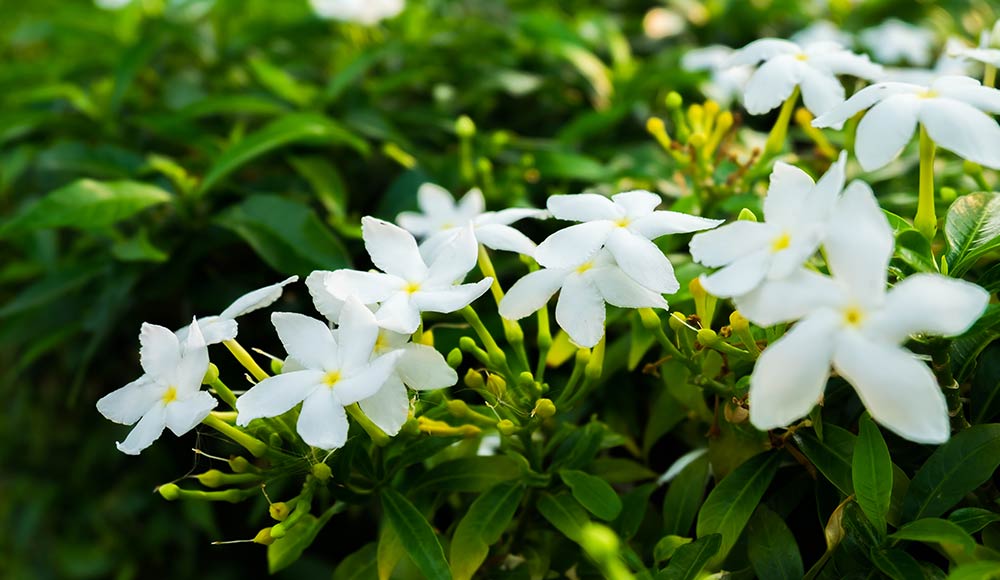


By Gilmour
Delicate and dainty with small flowers, jasmine is known around the world for its unique tropical smell and pretty blossoms that attract bees. The jasmine flower is usually white, although some species are yellow or cream, and it can bloom all year long. Jasmine can grow in a pot or hanging basket. It can also be planted directly in the ground and trained to climb or grow as bushes or ground cover.
Interested in growing Jasmine? Learn everything there is to know about jasmine plant care so you can enjoy its sweet-smelling flower and full, hardy look.
Jasmine flowers are tropical blooms that thrive in warmer climates. Most varieties have a distinct scent that is popular even off the vine. The smell of jasmine can be found in everything from teas to candles to soaps to lotion. Jasmine has bright green, glossy foliage and likes sun to light shade and relatively fertile, well-drained soil. Some jasmine plants are evergreen, meaning they will keep their green leaves year-round. While growing jasmine does require some effort, it’s well worth it, as the plant will put on a profuse, showy display of blooms that can liven up even the dullest of yards.
Planting jasmine is easy. Just follow these simple tips.
Jasmine is not particularly hard to care for, but it does require some attention in the beginning and needs regular feeding and pruning. Learn how to care for a jasmine plant below.
Jasmine is a member of the olive family. The most common types are grown as vines, but there are some varieties that work as ground covers or shrubs, too. There are about 200 different species of jasmine, which is native to warmer, temperate tropical climates. Jasmine plant types will all have slightly different needs, so it is important to know about the varieties before choosing which one to plant.
Jasmine is a perennial that will grow year after year. Different varieties have different watering, space and sunlight needs depending on what zone they are growing in.
All types of jasmine will do well in full sun to partial shade – exactly how much sun a plant needs each day will depend on the variety.
Jasmine can grow both indoors and outdoors. Dwarf varieties do best indoors, but vines can also thrive inside the home. Just pinch or prune the plant in the dormant season to maintain the desired height and shape.
Many gardeners choose to grow jasmine in containers so they can bring the plant indoors over winter. If bringing jasmine inside because of extreme cold, do so gradually, over about a week or so, to allow the plant time to adjust to less sun once indoors. A good way to make this transition is by bringing the plant in at night, and then returning it outside during the day time, increasing the hours you leave it inside throughout the week. Once it is inside permanently, place it in the sunniest spot of the house.
Jasmine blooms in clusters from spring until well into the fall. The sweet flowers are most often cream, white or yellow, depending on the variety, and will attract bees and other pollinators.
With enough sun and the right watering and feeding, jasmine flowers will stay open and fresh for you to enjoy for several months.
From the moment you pick it up, you’ll notice these nozzles are different. Designed with mobility in mind, they feature Gilmour’s innovative Swivel Connect. The swivel allows the nozzles to pivot without
Learn MoreWinter Gardening Tips to Tackle in the Off Season
As winter marches on, avid gardeners become more and more eager to get growing. While you may not be able to dig your spade into the soil just yet, there is plenty
Learn MoreDesign a Beautiful Drought Resistant Yard
Hot weather and drought-like conditions don’t mean a beautiful yard and garden is out of reach. Learn everything you need to know about drought tolerant landscaping, including the best type of plants,
Get the Dirt